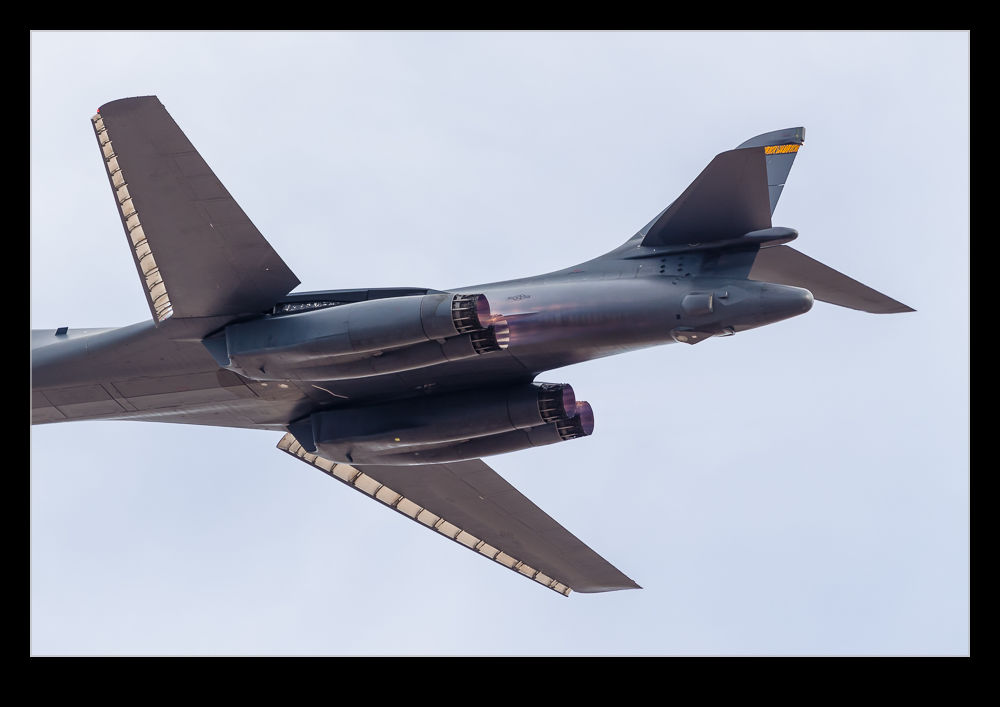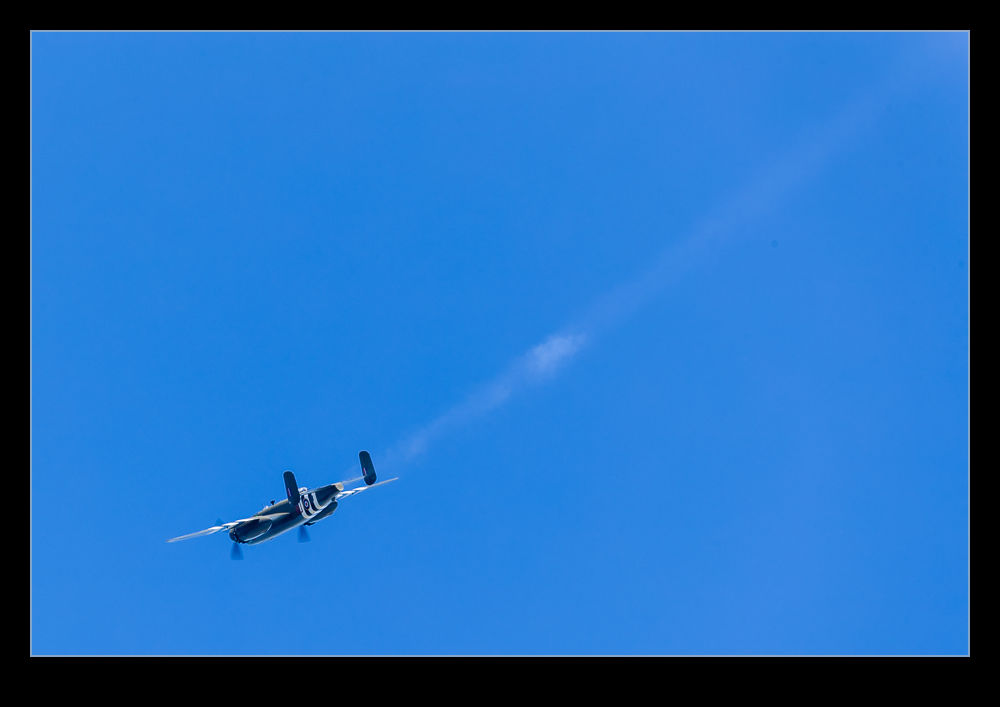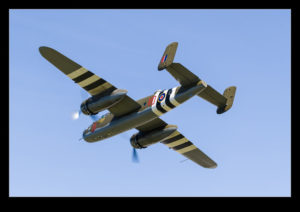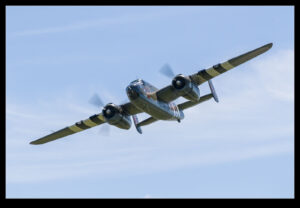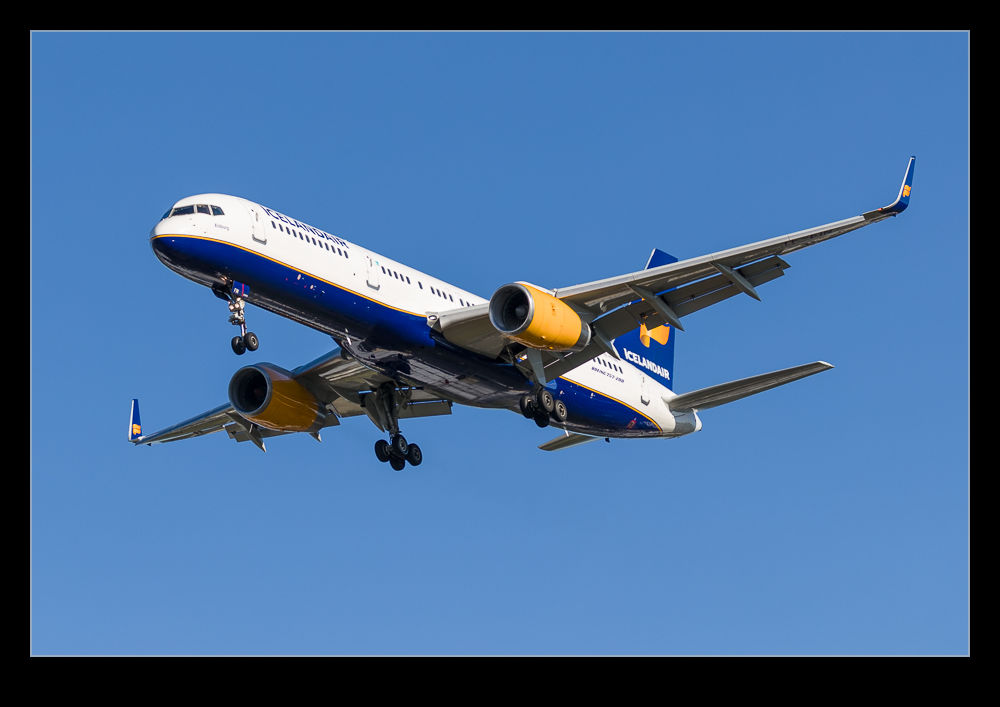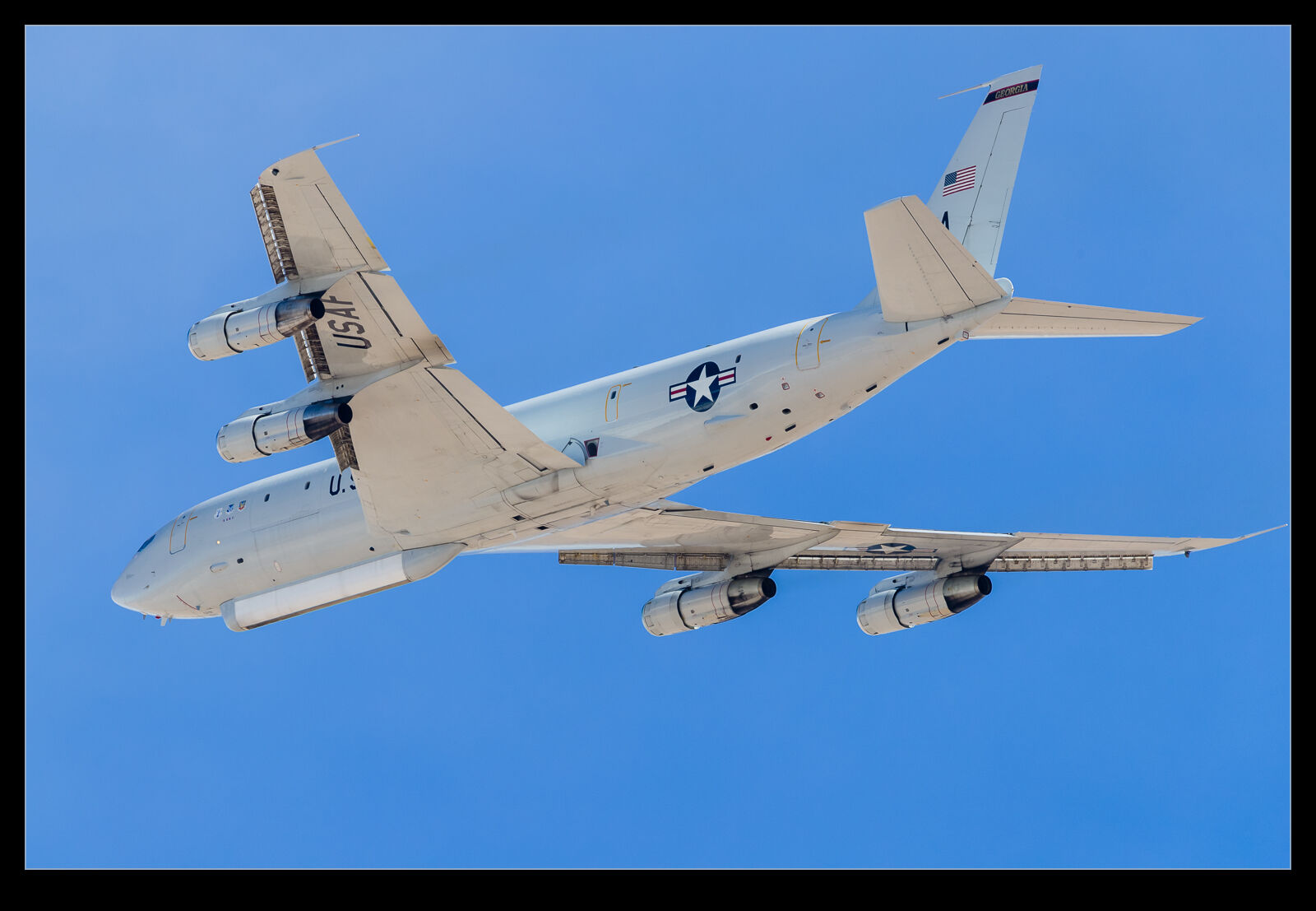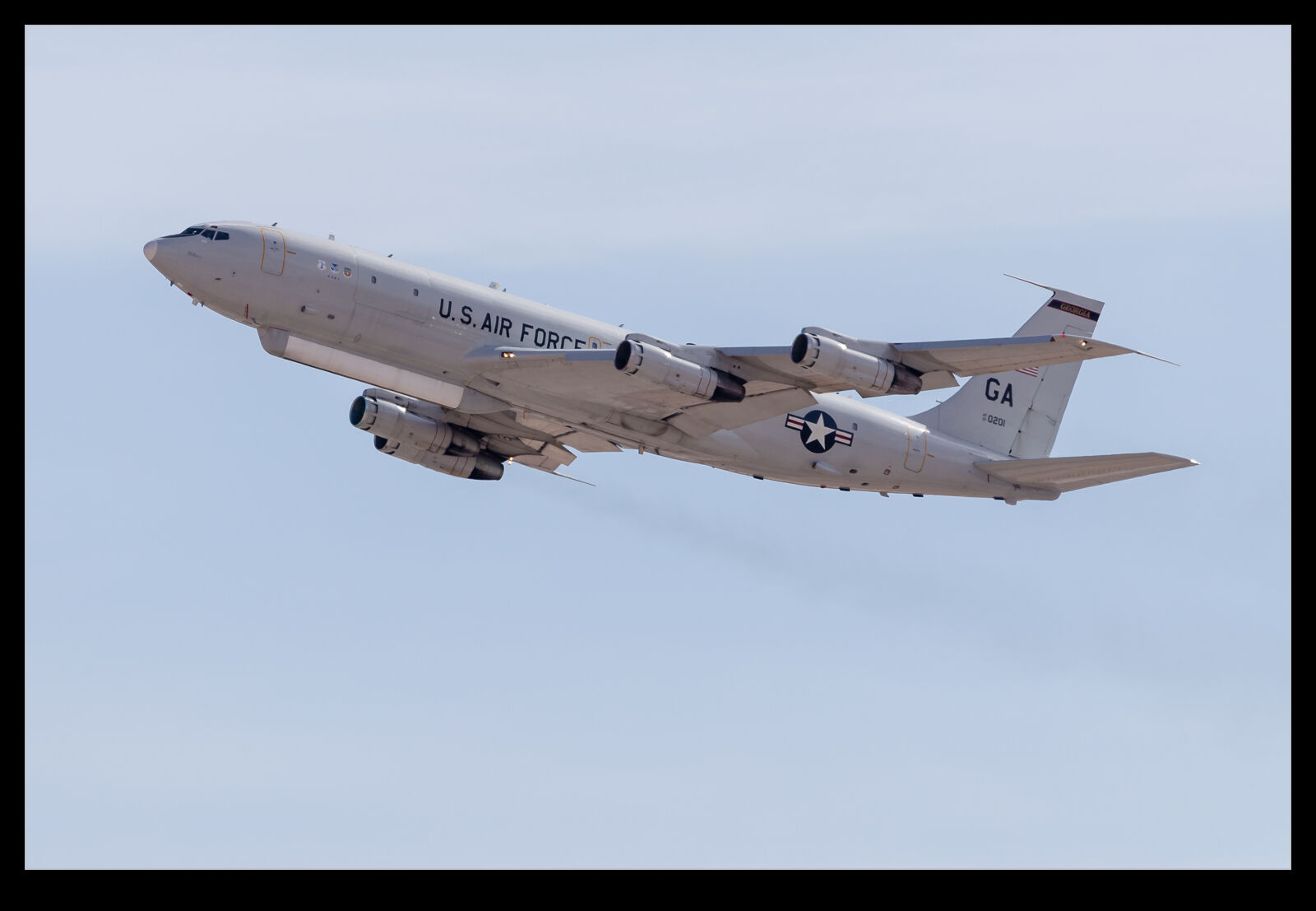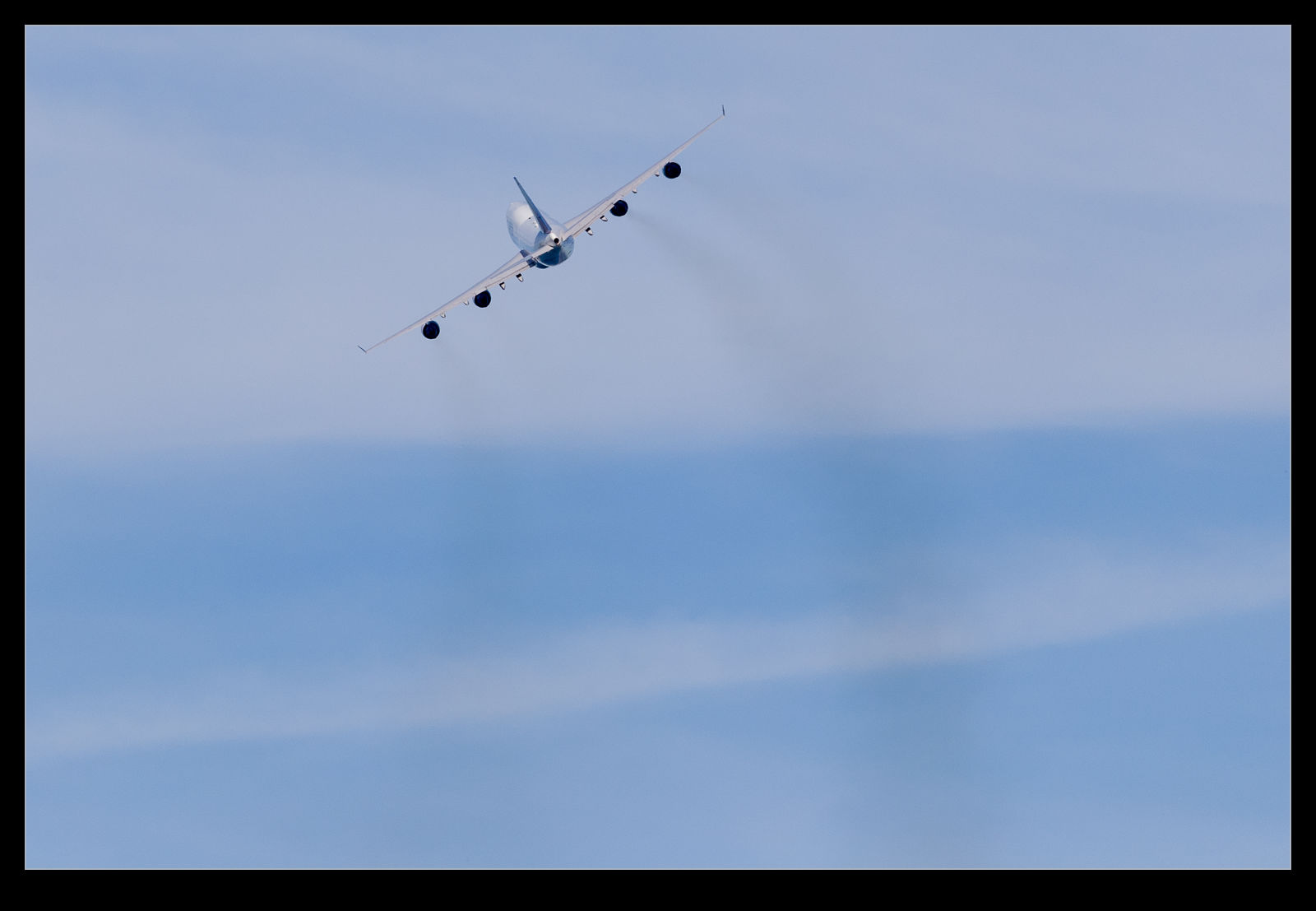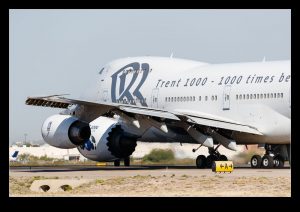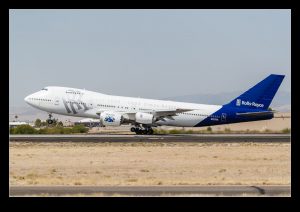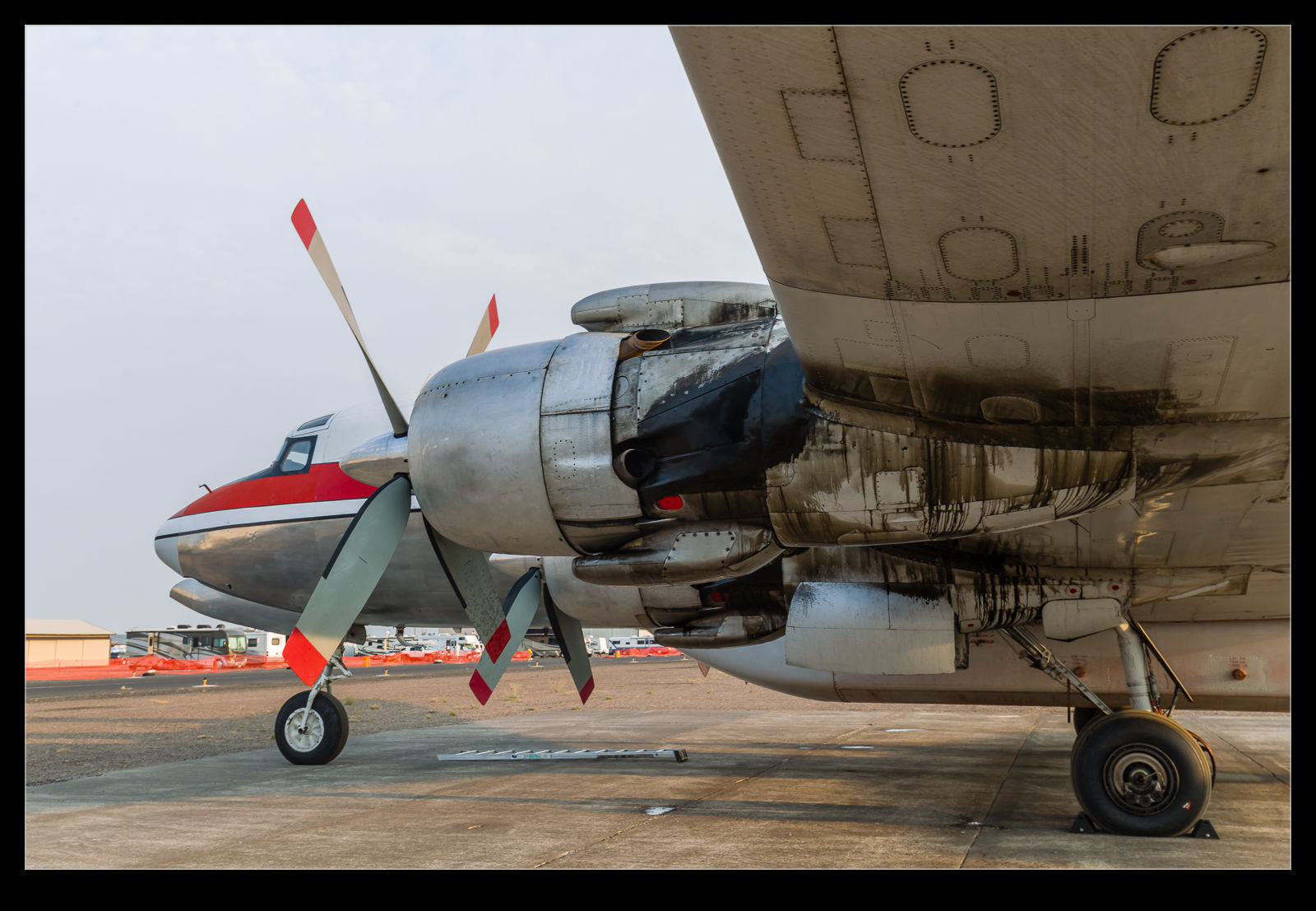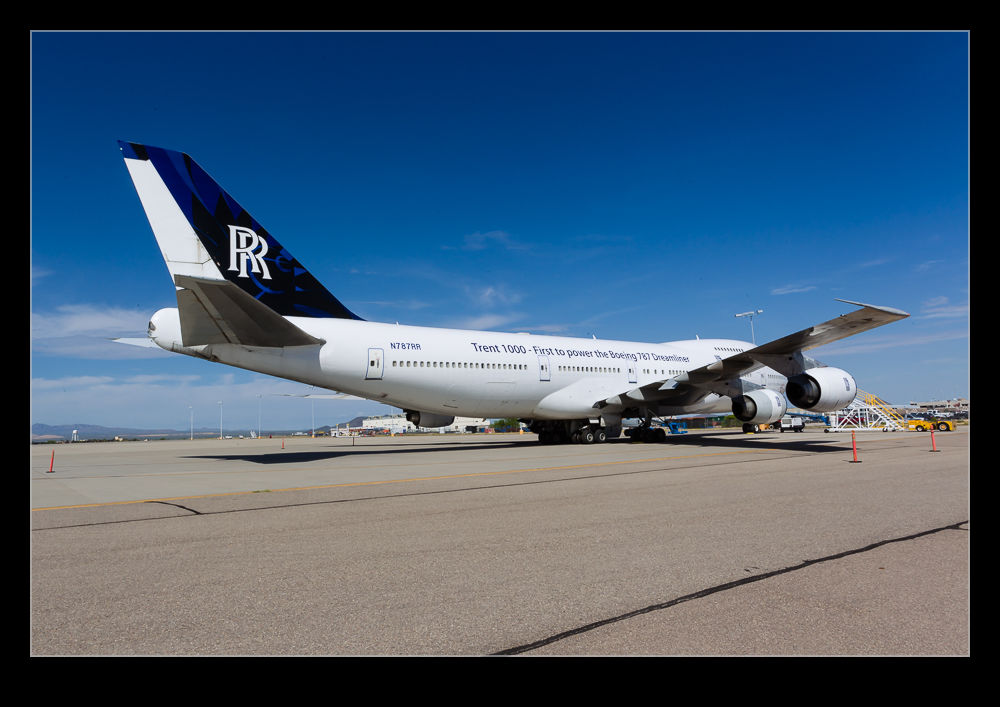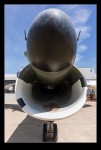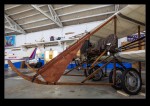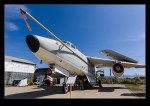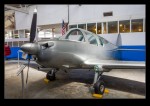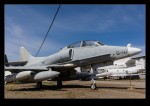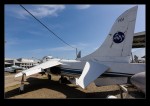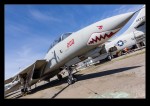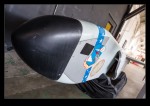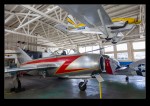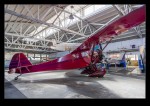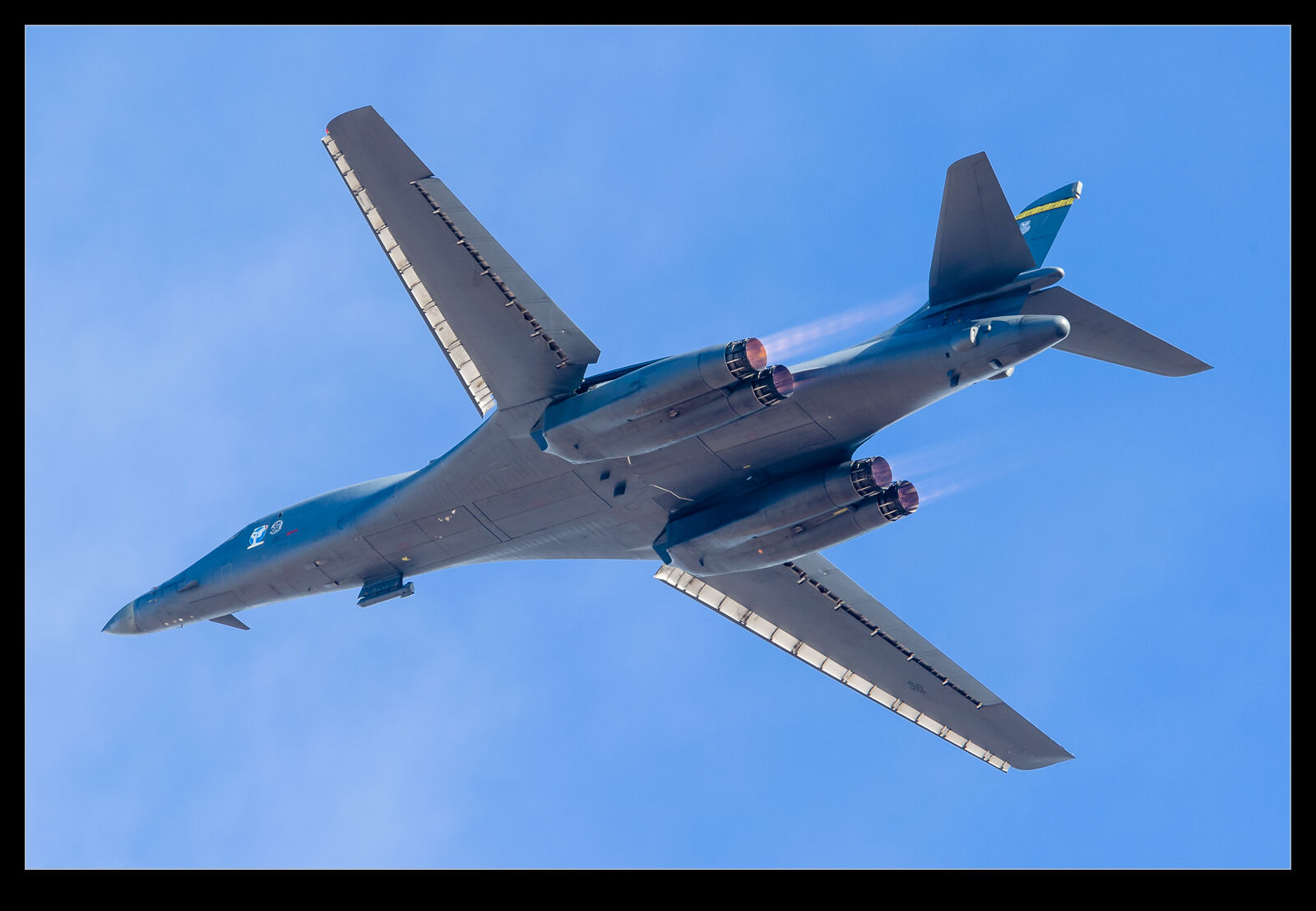 I’ve already shown the B-1s at Red Flag some love but here is a bit more about them because, well, why not? The four afterburning engines produce a lot of noise, light and, I guess, thrust. For a few of the departures, I focused the camera on the back end to try and show that energetic output. Daylight is not the best time to show up the afterburner plume – night works well for that as does being more directly behind the jet – but it still is possible to see the jet against the dark airframe. This is just something so impressive to see.
I’ve already shown the B-1s at Red Flag some love but here is a bit more about them because, well, why not? The four afterburning engines produce a lot of noise, light and, I guess, thrust. For a few of the departures, I focused the camera on the back end to try and show that energetic output. Daylight is not the best time to show up the afterburner plume – night works well for that as does being more directly behind the jet – but it still is possible to see the jet against the dark airframe. This is just something so impressive to see.
Tag Archives: engine
Consequences of a Doolittle Style Takeoff
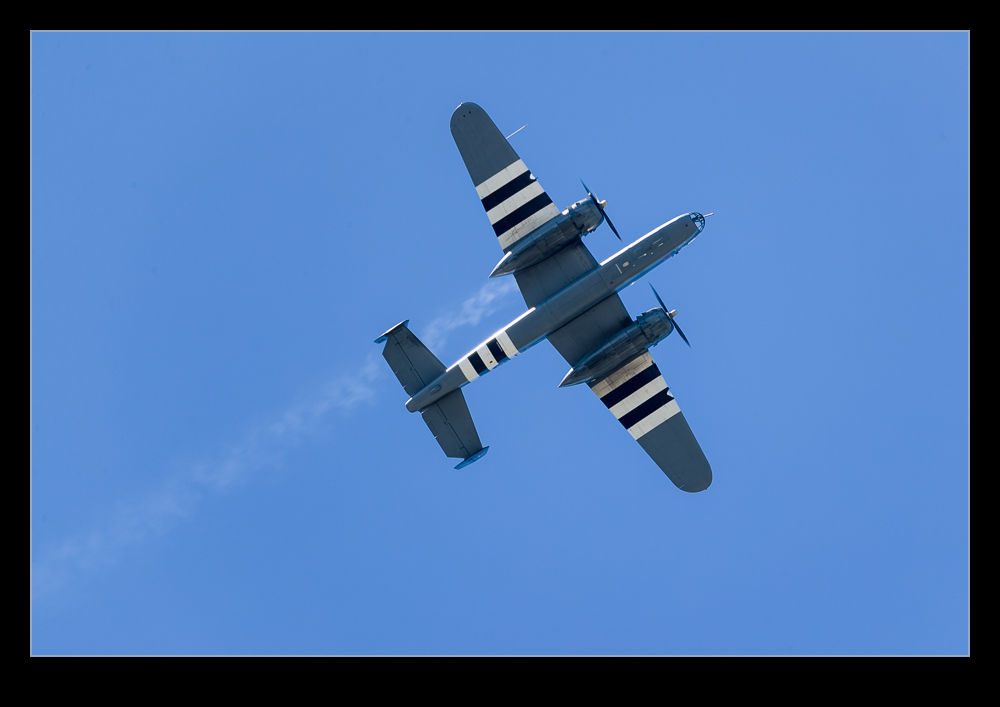 Grumpy got airborne using the Doolittle technique I posted about here. During the takeoff, there were some puffs of smoke from one of the engines. Initially I thought this might just be some oil blowing through but, as they climbed out, the output from the engine was clearly not as it should be and the one engine was clearly not healthy. They cut short the flight (although not as short as it could have been) and brought the plane back down. I saw Grumpy fly a few weeks later so I guess they dealt with whatever the issue was.
Grumpy got airborne using the Doolittle technique I posted about here. During the takeoff, there were some puffs of smoke from one of the engines. Initially I thought this might just be some oil blowing through but, as they climbed out, the output from the engine was clearly not as it should be and the one engine was clearly not healthy. They cut short the flight (although not as short as it could have been) and brought the plane back down. I saw Grumpy fly a few weeks later so I guess they dealt with whatever the issue was.
Icelandic Veteran With a Smoky Engine
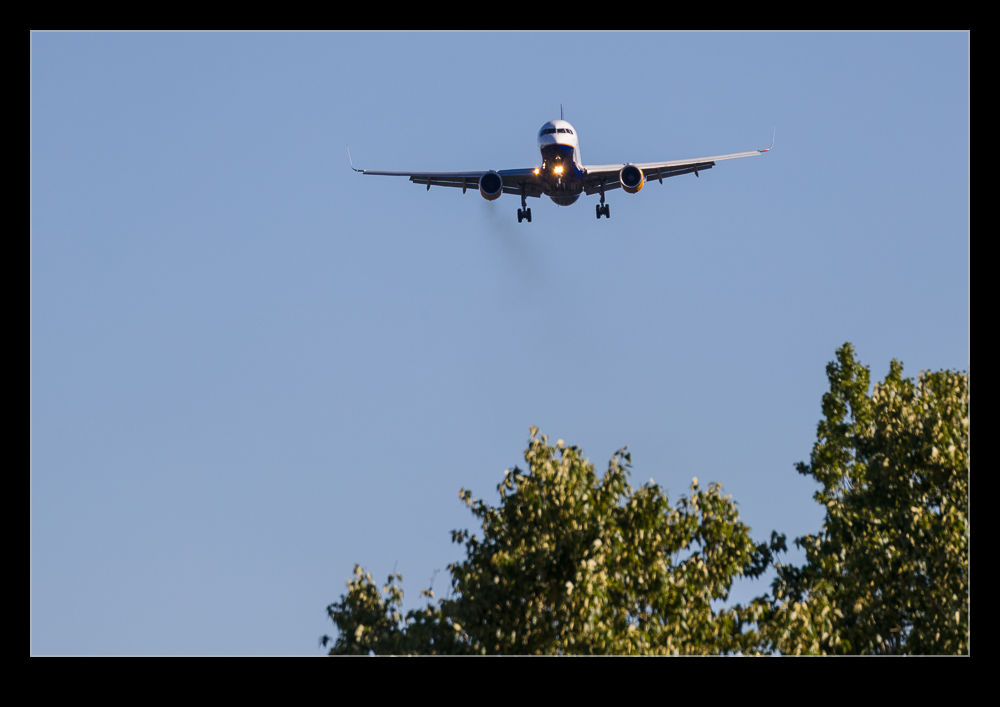 Icelandair has made a good business of operating Boeing 757s on routes from Iceland to the US with Seattle being a regular destination for years. There was a time when the 757 was a cutting-edge jet but these days they are getting up in years. Similarly, the RB211-535E4 was once considered very advanced. Now, it is dated. It turns out that one of the engines on this flight is in a little better shape than the other. As they cycled the power on the approach, the starboard engine was noticeably smokier. Not a big deal but I guess it has been on the wing a little longer than its partner.
Icelandair has made a good business of operating Boeing 757s on routes from Iceland to the US with Seattle being a regular destination for years. There was a time when the 757 was a cutting-edge jet but these days they are getting up in years. Similarly, the RB211-535E4 was once considered very advanced. Now, it is dated. It turns out that one of the engines on this flight is in a little better shape than the other. As they cycled the power on the approach, the starboard engine was noticeably smokier. Not a big deal but I guess it has been on the wing a little longer than its partner.
Smokey the E-8
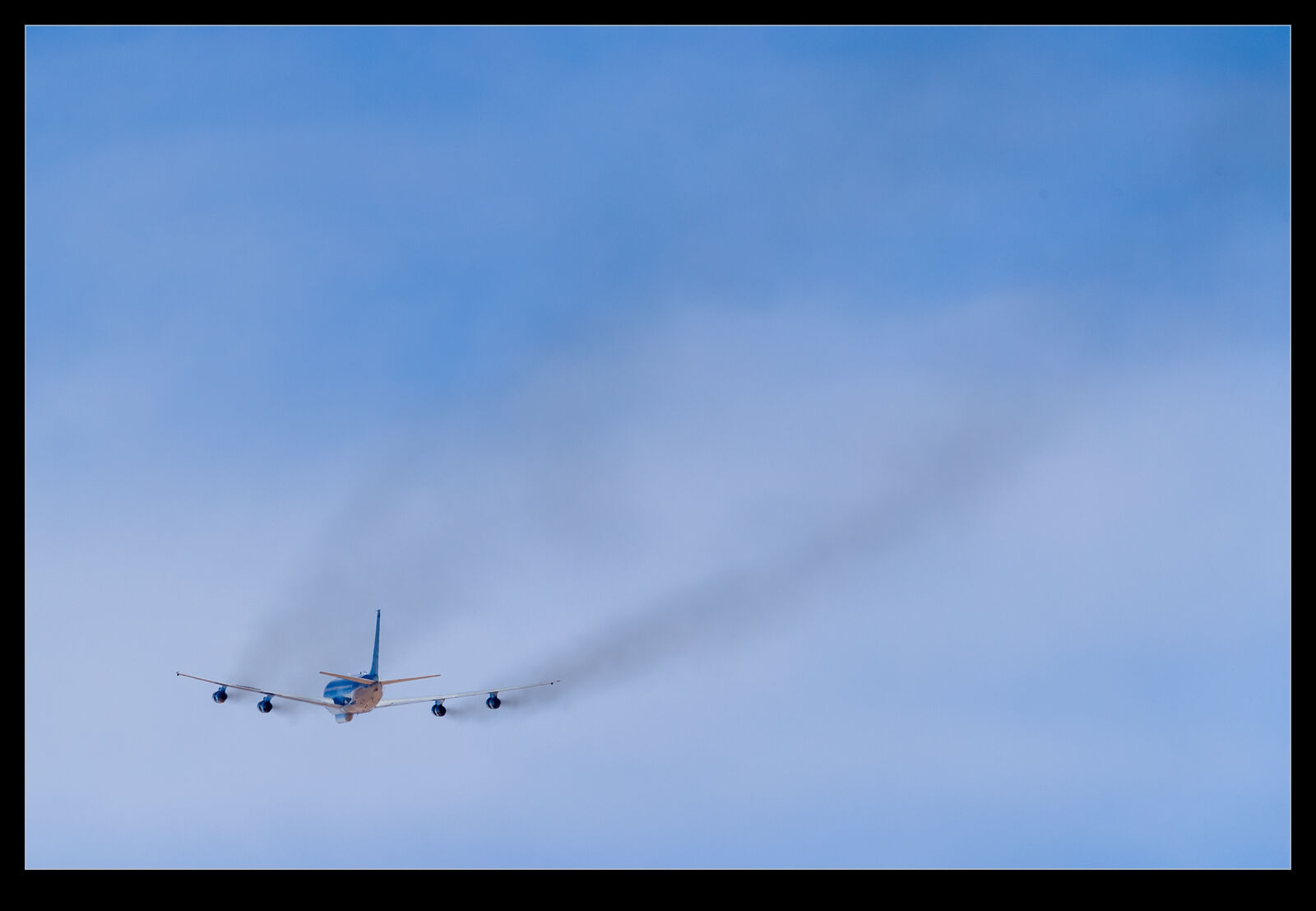 A jet I don’t often get to see in action is the E-8 JSTARS. There aren’t a huge number of them and they often fly at times that don’t suit photography so I have not previously got a lot of shots of them and certainly not too many in flight. Based on the 707-300 airframe, they were pretty old when they were selected for conversion to the JSTARs mission. They are definitely showing their age and the USAF is in the process of competing for a replacement program. There are a few years left for the E-8 but they won’t be around for too much longer.
A jet I don’t often get to see in action is the E-8 JSTARS. There aren’t a huge number of them and they often fly at times that don’t suit photography so I have not previously got a lot of shots of them and certainly not too many in flight. Based on the 707-300 airframe, they were pretty old when they were selected for conversion to the JSTARs mission. They are definitely showing their age and the USAF is in the process of competing for a replacement program. There are a few years left for the E-8 but they won’t be around for too much longer.
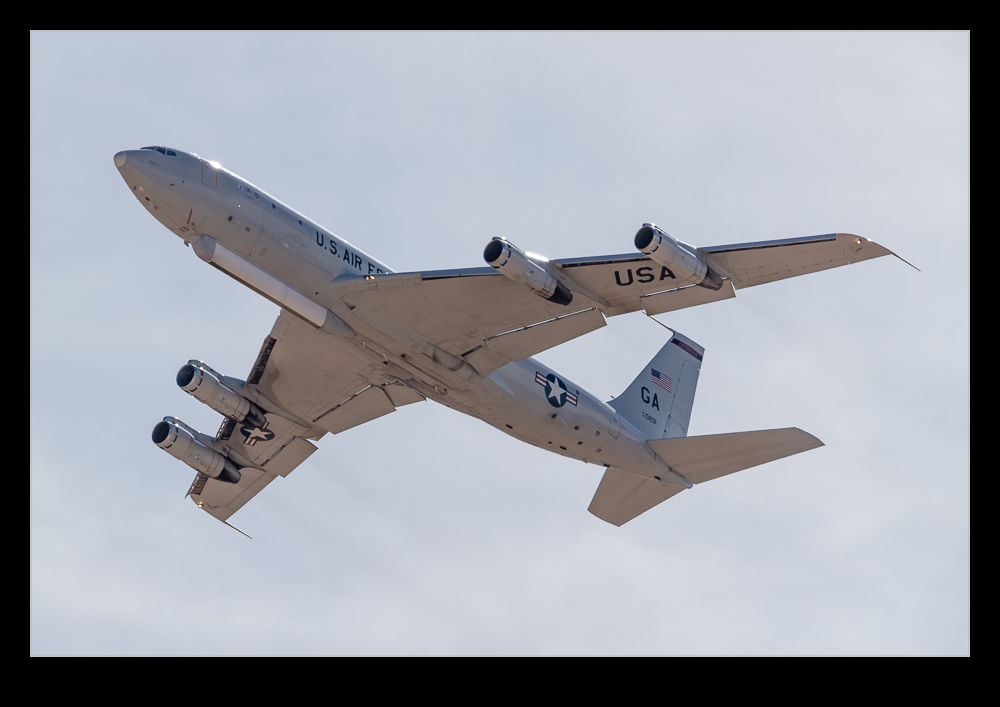 One feature of their age is the engines that they have. The jets are fitted with old JT3D engines. A program had been put in place to re-engine them with JT8Ds and a modified jet did fly. However, the program was put on hold due to the potential for a replacement aircraft making the payback period unviable. As a result, we got the old smoky jets. It isn’t as bad as the old pure jet days of the KC-135s and B-52s but it still is easy to track the jet as it climbs out courtesy of the black trail it leaves behind.
One feature of their age is the engines that they have. The jets are fitted with old JT3D engines. A program had been put in place to re-engine them with JT8Ds and a modified jet did fly. However, the program was put on hold due to the potential for a replacement aircraft making the payback period unviable. As a result, we got the old smoky jets. It isn’t as bad as the old pure jet days of the KC-135s and B-52s but it still is easy to track the jet as it climbs out courtesy of the black trail it leaves behind.
Anyone Order Some Engines?
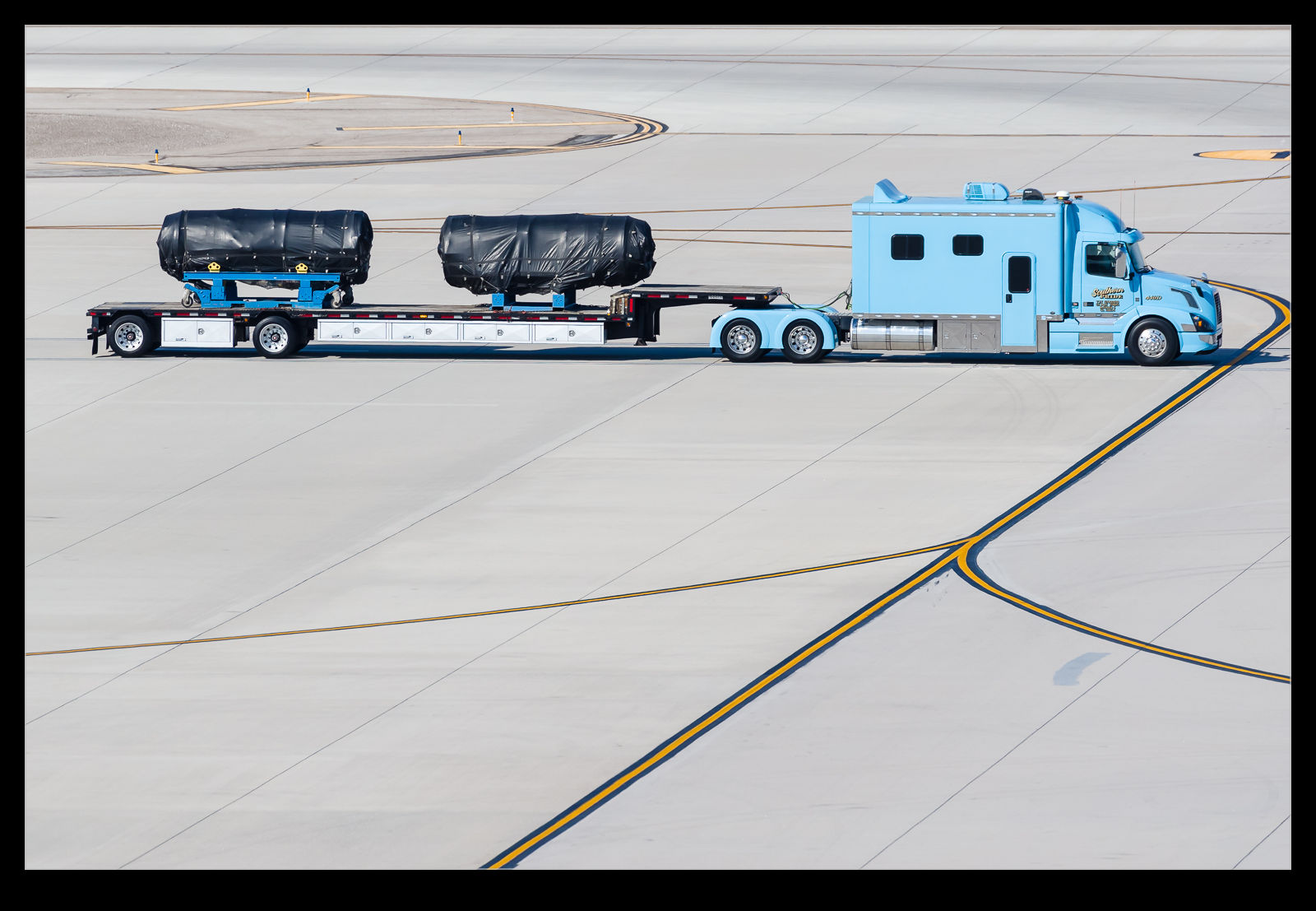 Modern engines last a long time on the wing of an airliner but they do need to be changed. Older engines tend to need to be changed more often. Allegiant fly a bunch of MD-80s as part of their fleet and they use the older Pratt and Whitney JT-8D engines. I guess one of the planes was due for a change because, while I was at McCarran, this truck showed up on the ramp with a couple of engines on the trailer. I can’t say whether these were fresh engines about to be fitted or the ones that had come off due for overhaul but, judging by the direction he was heading, I am going to say that these were being delivered.
Modern engines last a long time on the wing of an airliner but they do need to be changed. Older engines tend to need to be changed more often. Allegiant fly a bunch of MD-80s as part of their fleet and they use the older Pratt and Whitney JT-8D engines. I guess one of the planes was due for a change because, while I was at McCarran, this truck showed up on the ramp with a couple of engines on the trailer. I can’t say whether these were fresh engines about to be fitted or the ones that had come off due for overhaul but, judging by the direction he was heading, I am going to say that these were being delivered.
Number Two is Cleaner
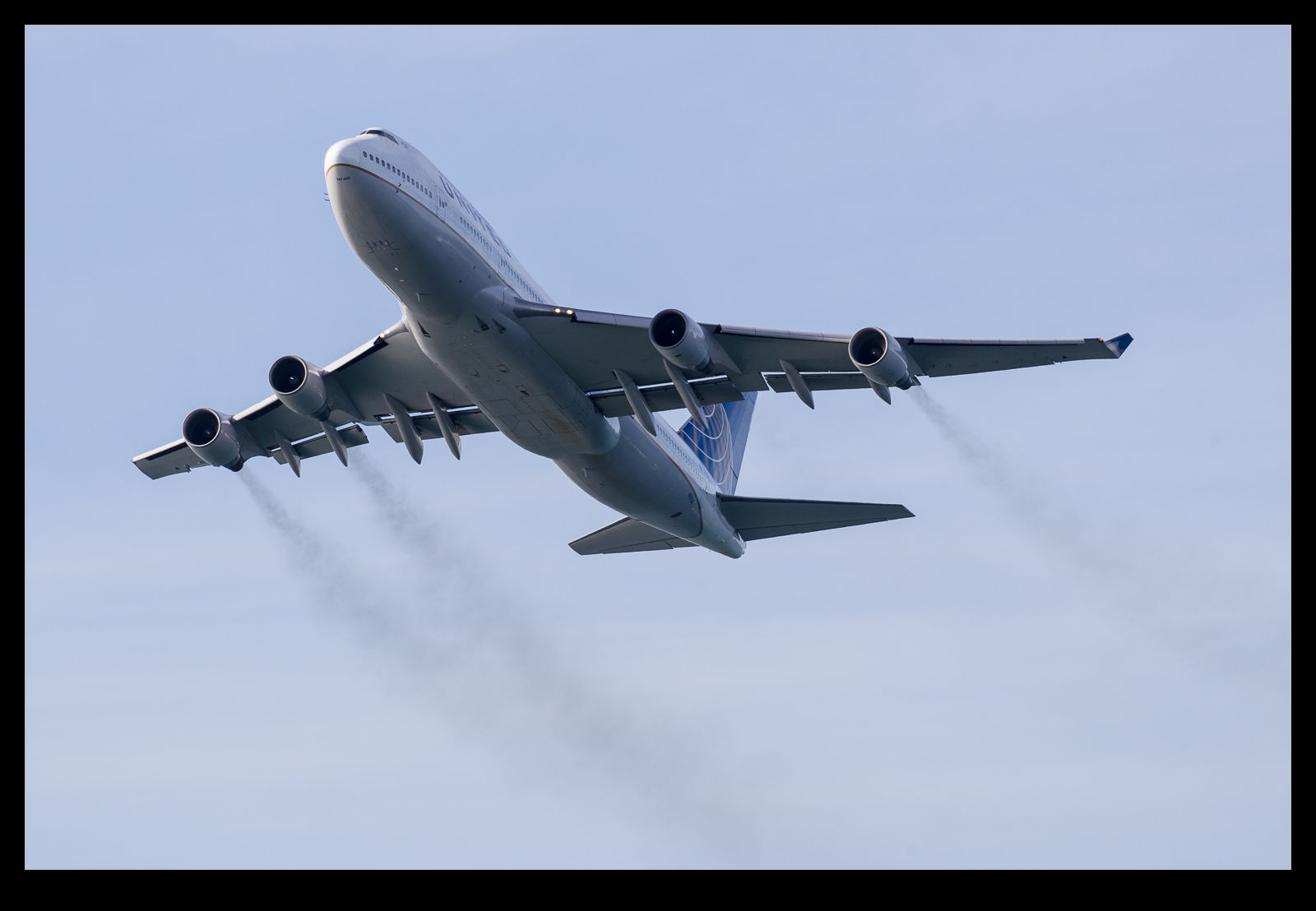 This United 747 was flying over the Bay during the Fleet Week display as I posted about in this post. One thing that was very obvious as the aircraft was put through its paces by the crew was that the number two engine seemed to be burning a lot cleaner than the other three. You wouldn’t pay much attention to the exhaust of a jet except when there is a clear discrepancy and, in this case, the number two was so obviously less smoky, I noticed. Maybe it was fresh from overhaul.
This United 747 was flying over the Bay during the Fleet Week display as I posted about in this post. One thing that was very obvious as the aircraft was put through its paces by the crew was that the number two engine seemed to be burning a lot cleaner than the other three. You wouldn’t pay much attention to the exhaust of a jet except when there is a clear discrepancy and, in this case, the number two was so obviously less smoky, I noticed. Maybe it was fresh from overhaul.
Rolls’ Testbed Flies While I Am There – Twice!
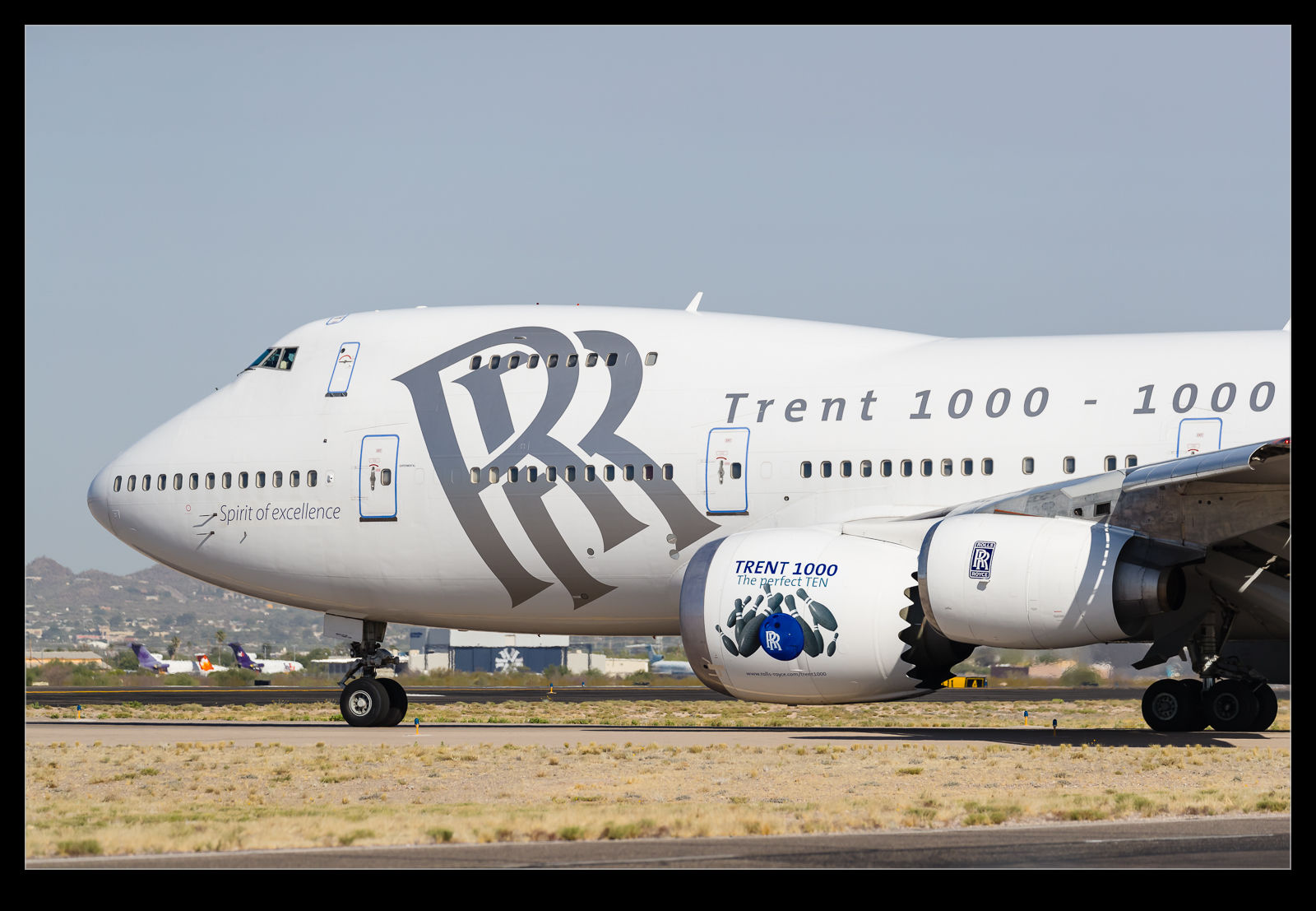 On my previous visit to Tucson, I saw the Rolls Royce owned Boeing 747 engine testbed. This was converted for the Boeing 787 Trent engine development program (hence the registration N787RR). The Number Two engine was removed and replaced with the test engine. The other three Rolls RB211s are unchanged. At various times the testbed has been reported to be without an engine in the test location but there was something there when I was last here – it’s just they didn’t fly. This time was different.
On my previous visit to Tucson, I saw the Rolls Royce owned Boeing 747 engine testbed. This was converted for the Boeing 787 Trent engine development program (hence the registration N787RR). The Number Two engine was removed and replaced with the test engine. The other three Rolls RB211s are unchanged. At various times the testbed has been reported to be without an engine in the test location but there was something there when I was last here – it’s just they didn’t fly. This time was different.
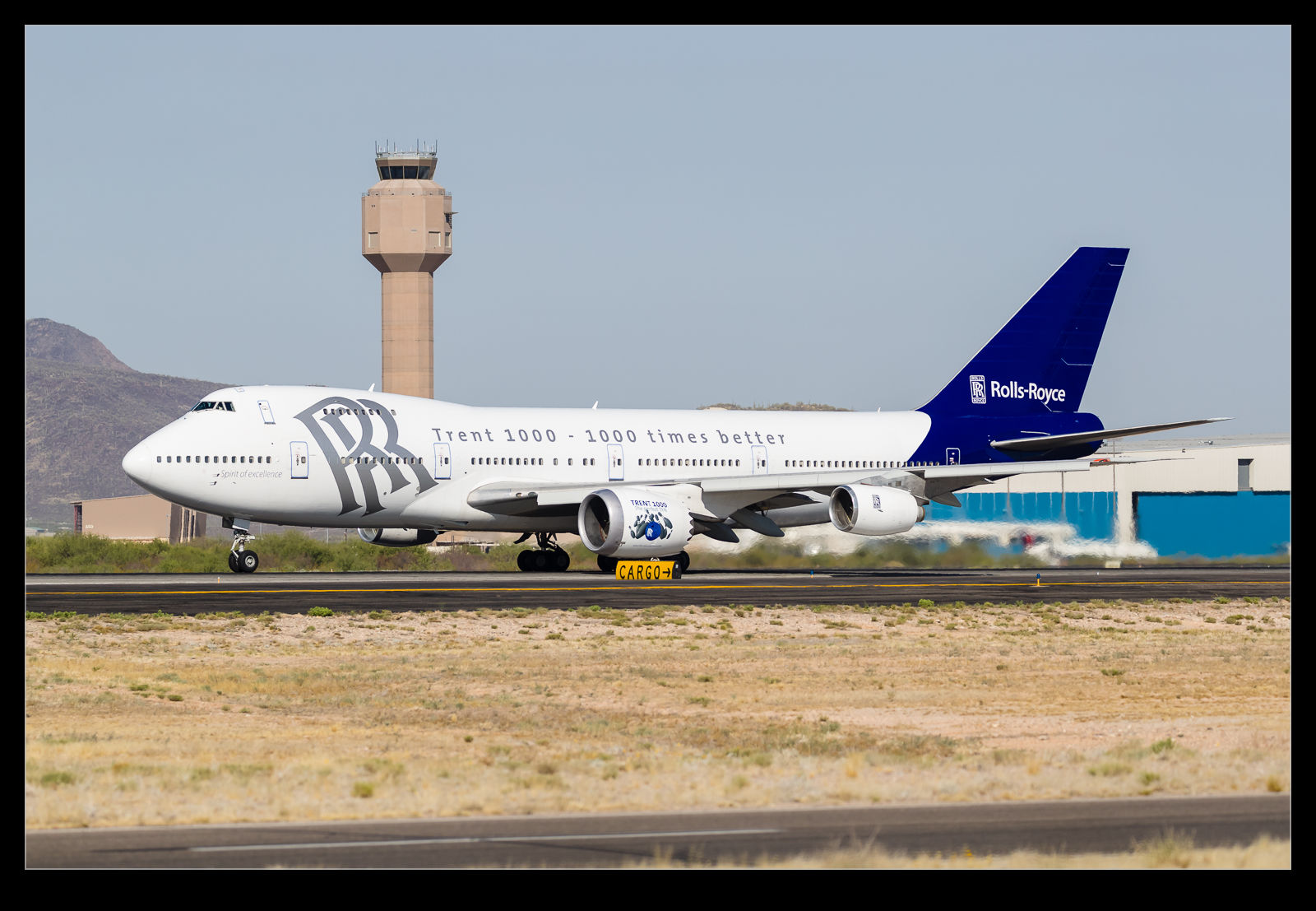 I saw the testbed when I left the airport after my flight landed. The following morning, I headed out to see what F-16 traffic there was and saw online that a flight plan had been filed for the testbed. I only had a certain amount of time before I was due to be at Hawgsmoke but it was supposed to fly long before that. Of course, test flying is not usually something that happens to a tight schedule and the takeoff time came and went. We were beginning to think we might miss it when the sound of some large engines spooling up reached us. A while later, out she came.
I saw the testbed when I left the airport after my flight landed. The following morning, I headed out to see what F-16 traffic there was and saw online that a flight plan had been filed for the testbed. I only had a certain amount of time before I was due to be at Hawgsmoke but it was supposed to fly long before that. Of course, test flying is not usually something that happens to a tight schedule and the takeoff time came and went. We were beginning to think we might miss it when the sound of some large engines spooling up reached us. A while later, out she came.
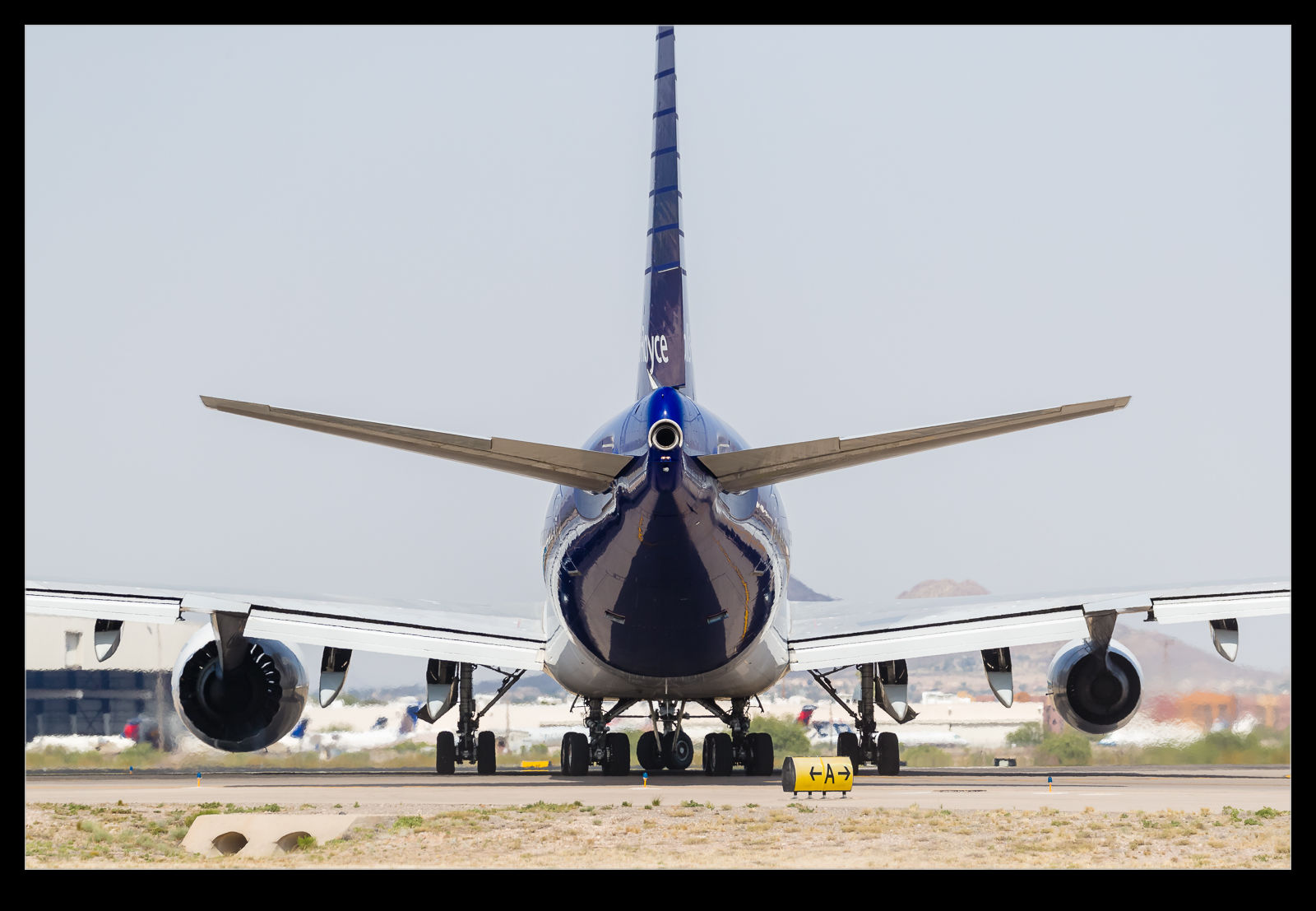 Engine testbeds require some careful control. Since one engine is significantly different in thrust from the others, there is a balancing act required to keep the thrust differential within the ability of the control surfaces to overcome. That means the max thrust is not always going to be used. Consequently, they use a good portion of the runway for takeoff rotating just passed our location. That meant I didn’t get the front quarter rotation shot I had in mind.
Engine testbeds require some careful control. Since one engine is significantly different in thrust from the others, there is a balancing act required to keep the thrust differential within the ability of the control surfaces to overcome. That means the max thrust is not always going to be used. Consequently, they use a good portion of the runway for takeoff rotating just passed our location. That meant I didn’t get the front quarter rotation shot I had in mind.
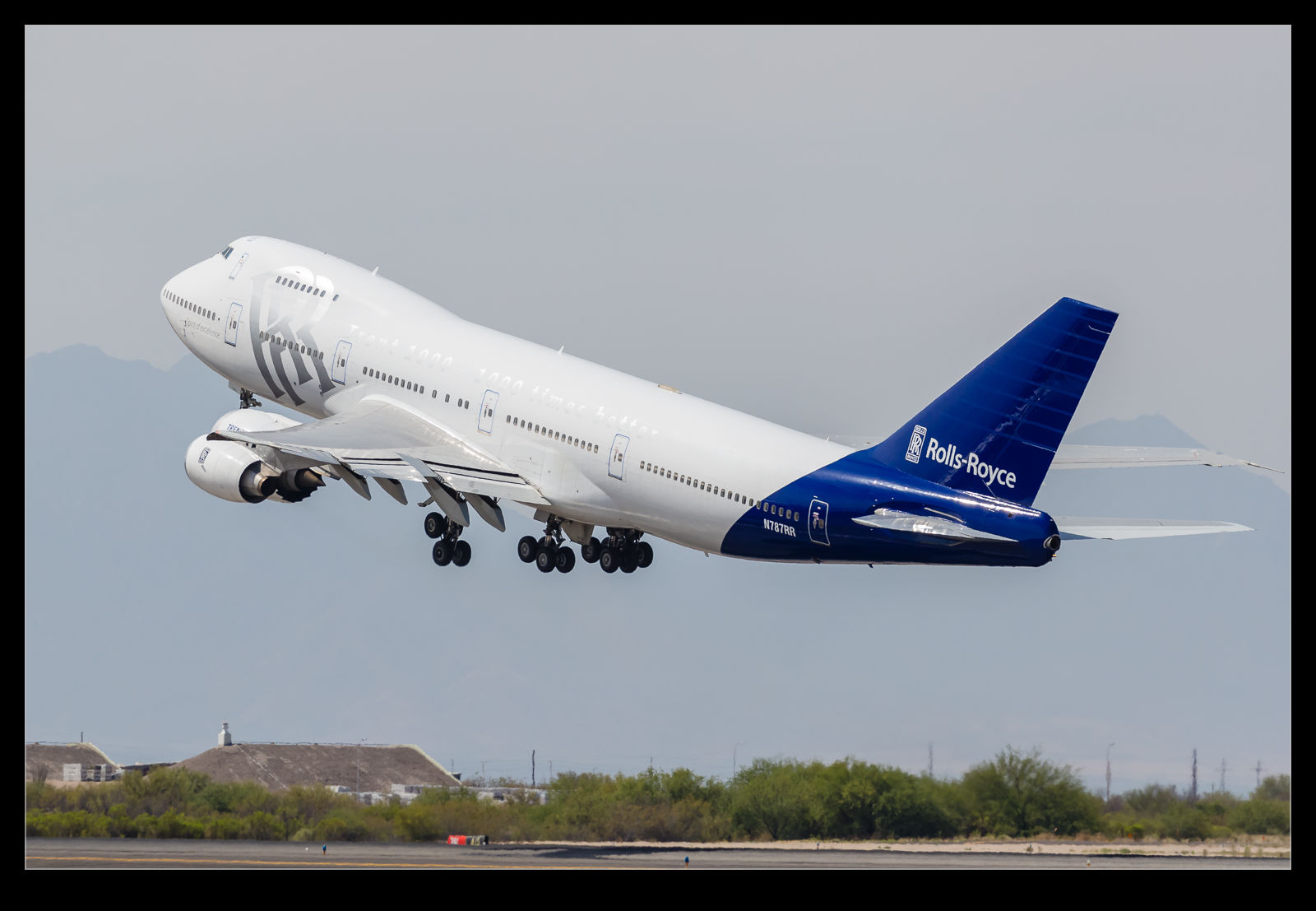 No matter, I still got to see it fly. The return was about six hours later and I was busy elsewhere at that time. I figured that was it for this trip. I was wrong. The morning of my departure, I had a little time to spare so went back to see what was happening. Amazingly, the testbed was already being crewed as I drove up. We got a repeat of the previous day and some similar shots. I guess I was compensating for not seeing it fly last time!
No matter, I still got to see it fly. The return was about six hours later and I was busy elsewhere at that time. I figured that was it for this trip. I was wrong. The morning of my departure, I had a little time to spare so went back to see what was happening. Amazingly, the testbed was already being crewed as I drove up. We got a repeat of the previous day and some similar shots. I guess I was compensating for not seeing it fly last time!
Is There Any Oil in This Thing?
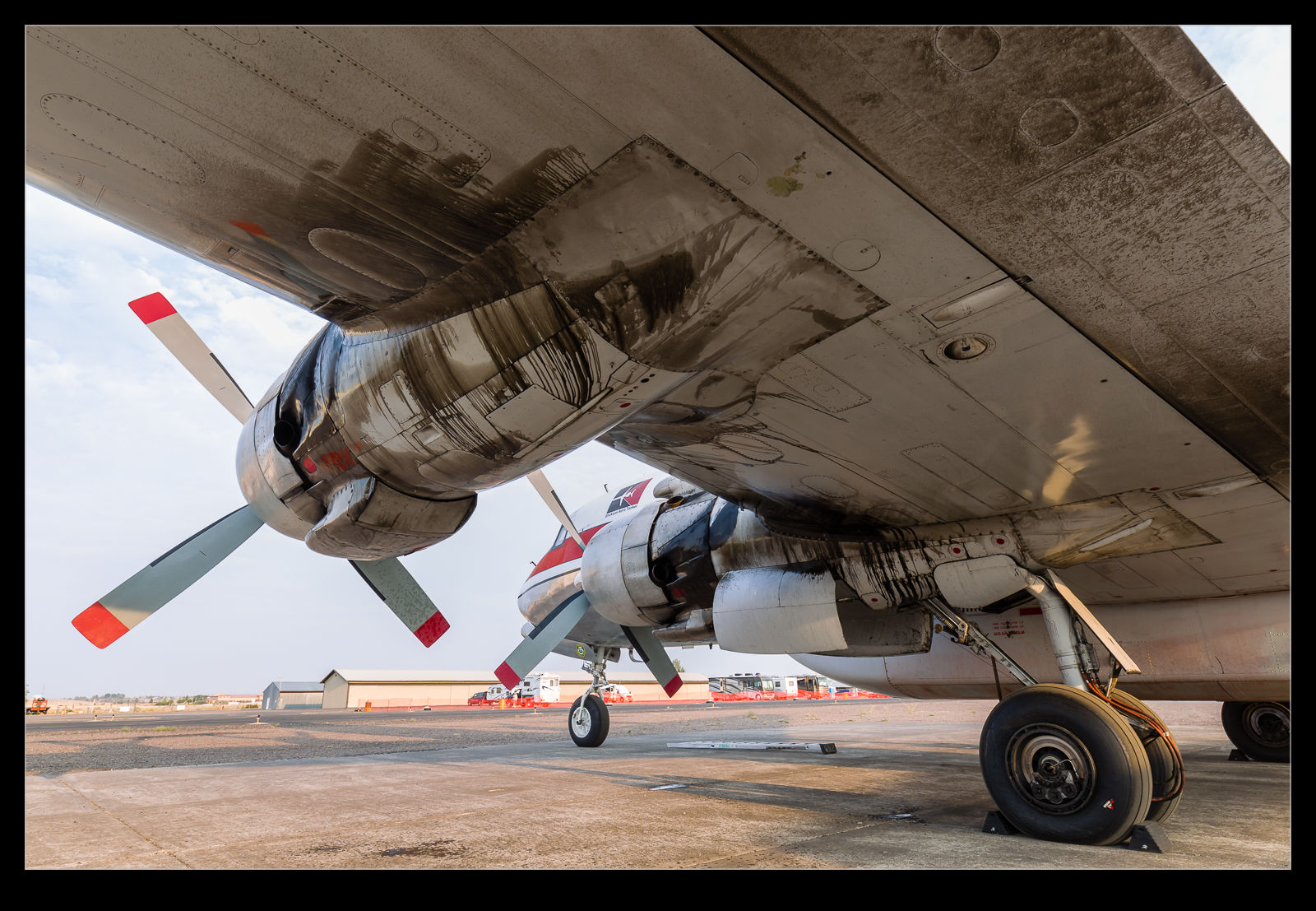 Parked up on the ramp at Erickson’s facility was a DC-7 tanker. It didn’t move while we were there so it became the target of a number of photographers at any one time. I shall show more of it shortly but one thing that caught my attention was the amount of oil on the engine nacelles. Old piston engines are well known for consuming oil at a prodigious rate and this beast was no exception. It seemed to have done a great job of relocating the oil from the internals of the engines to the outside of the nacelles. It made for some great patterns and this was what distracted me for a while as I walked around the aircraft.
Parked up on the ramp at Erickson’s facility was a DC-7 tanker. It didn’t move while we were there so it became the target of a number of photographers at any one time. I shall show more of it shortly but one thing that caught my attention was the amount of oil on the engine nacelles. Old piston engines are well known for consuming oil at a prodigious rate and this beast was no exception. It seemed to have done a great job of relocating the oil from the internals of the engines to the outside of the nacelles. It made for some great patterns and this was what distracted me for a while as I walked around the aircraft.
Rolls Royce Testbed
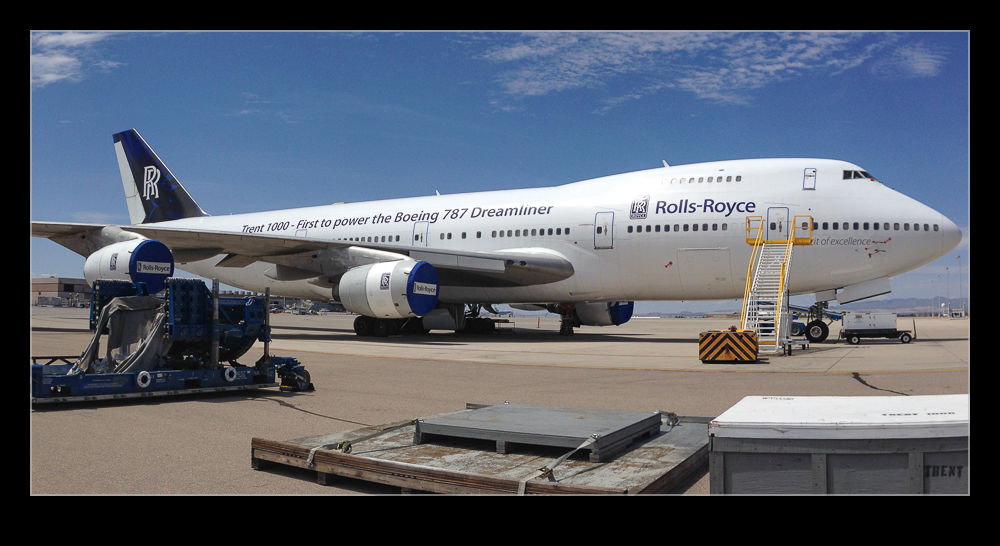 Something I hadn’t seen before was the Boeing 747 that Rolls Royce own and use as a testbed for the Trent 1000 engine on the Boeing 787. Appropriately registered N787RR, this was parked up close to a road. I actually spotted it first just as we landed. It was already dark and I saw the outline of the plane but had no idea what it was or why it was there. However, after picking up my rental car I came out near its parking spot so took a pass by. Being dark, there was nothing much to be shot but I decided to check it out again when it was daylight.
Something I hadn’t seen before was the Boeing 747 that Rolls Royce own and use as a testbed for the Trent 1000 engine on the Boeing 787. Appropriately registered N787RR, this was parked up close to a road. I actually spotted it first just as we landed. It was already dark and I saw the outline of the plane but had no idea what it was or why it was there. However, after picking up my rental car I came out near its parking spot so took a pass by. Being dark, there was nothing much to be shot but I decided to check it out again when it was daylight.
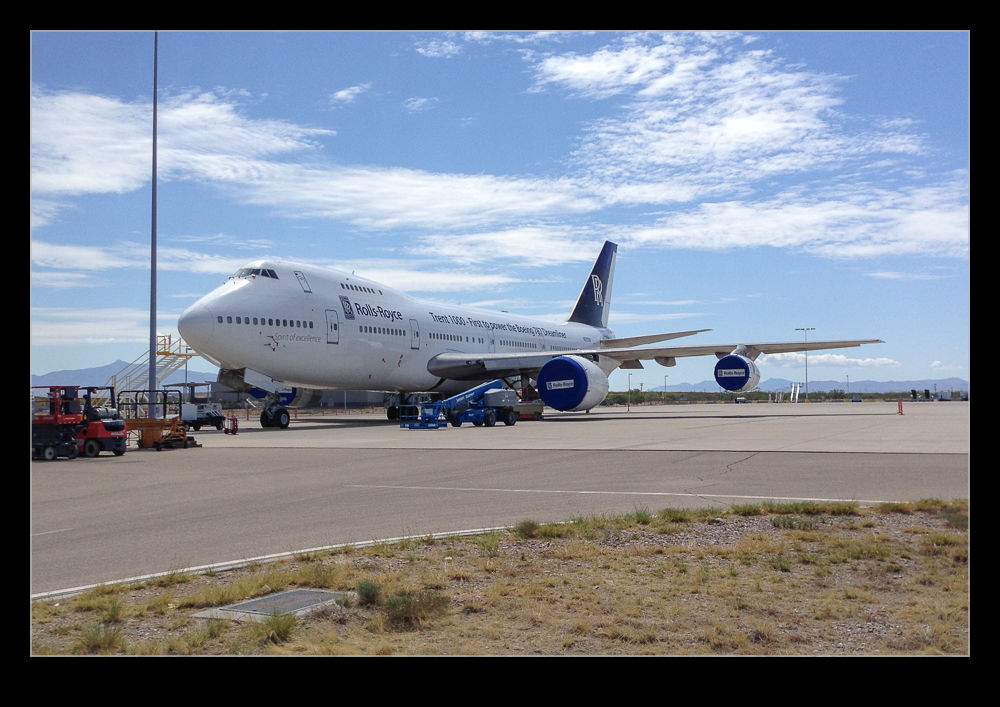 Apparently, this airframe had been sitting without the test engine for a while but there is now an engine fitted. Whether this means that they have been flying recently or are planning to soon I do not know. Unfortunately the test engine was on the side away from the road so was harder to show well in a shot. However, I still managed to get a few shots.
Apparently, this airframe had been sitting without the test engine for a while but there is now an engine fitted. Whether this means that they have been flying recently or are planning to soon I do not know. Unfortunately the test engine was on the side away from the road so was harder to show well in a shot. However, I still managed to get a few shots.
Oakland Aviation Museum
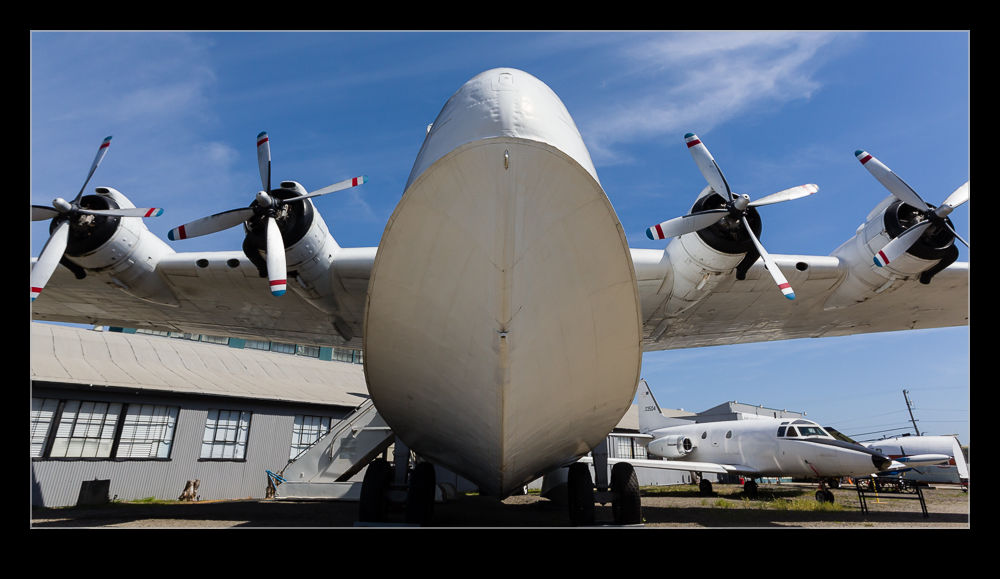 The aviation museum that is on the perimeter of Oakland Airport has been something I have passed a few times but never at a time when either I had enough spare time to visit or that it was actually open. Finally, I recently found myself coming by with some time in hand and decided to drop in and take a look around. The collection that they have is quite interesting and splits into a series of areas.
The aviation museum that is on the perimeter of Oakland Airport has been something I have passed a few times but never at a time when either I had enough spare time to visit or that it was actually open. Finally, I recently found myself coming by with some time in hand and decided to drop in and take a look around. The collection that they have is quite interesting and splits into a series of areas.
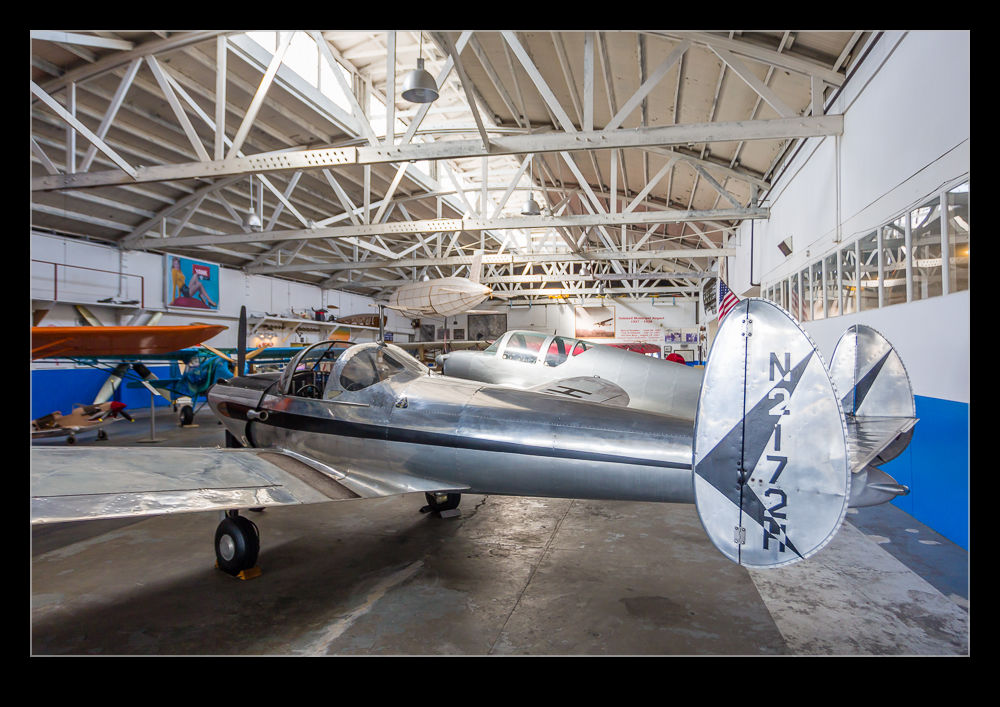 Obviously the aircraft are the major part of the displays. However, they do have a collection of aero engines, both piston and turbine, which span quite a period including a TF-30 from an F-14 Tomcat. There are displays of uniforms and historical sections on a variety of topics including individuals and airlines from the history of the area.
Obviously the aircraft are the major part of the displays. However, they do have a collection of aero engines, both piston and turbine, which span quite a period including a TF-30 from an F-14 Tomcat. There are displays of uniforms and historical sections on a variety of topics including individuals and airlines from the history of the area.
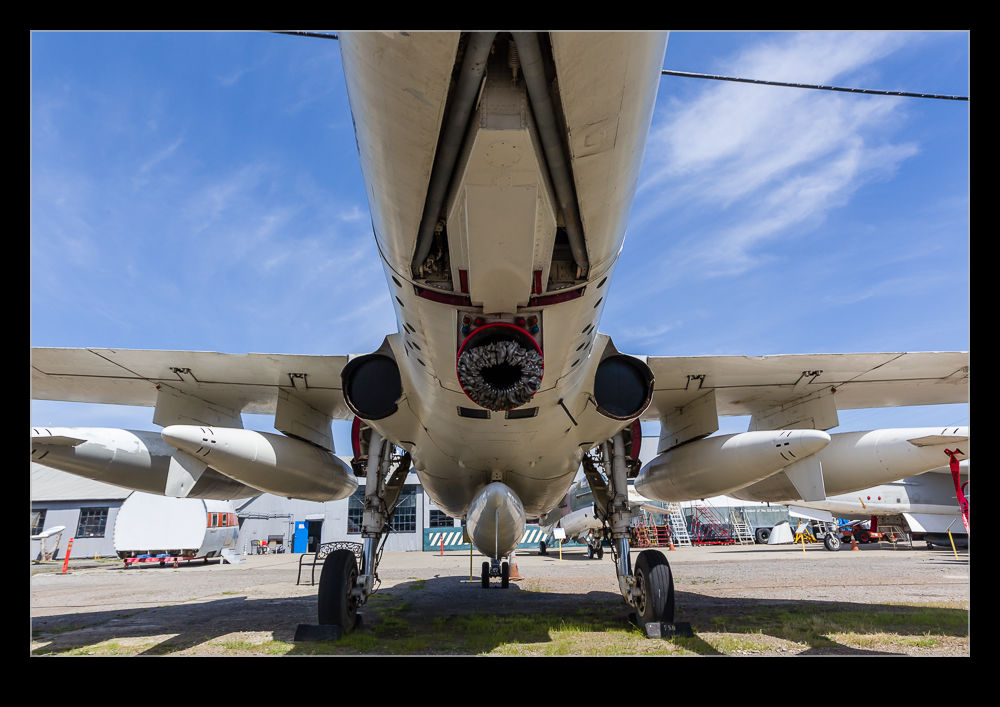 However, it was the aircraft that I was primarily interested in. Part of the collection is kept inside. It is a selection of types from some relatively familiar light aircraft like the Ercoupe, a replica Wright Biplane, a Boeing T-5 which is a unique type which was developed locally, the only example of the Hiller Ten99 which lost out to the Huey in an Army competition and a MiG-17. The internal displays are reasonably spread out although light is a little limited.
However, it was the aircraft that I was primarily interested in. Part of the collection is kept inside. It is a selection of types from some relatively familiar light aircraft like the Ercoupe, a replica Wright Biplane, a Boeing T-5 which is a unique type which was developed locally, the only example of the Hiller Ten99 which lost out to the Huey in an Army competition and a MiG-17. The internal displays are reasonably spread out although light is a little limited.
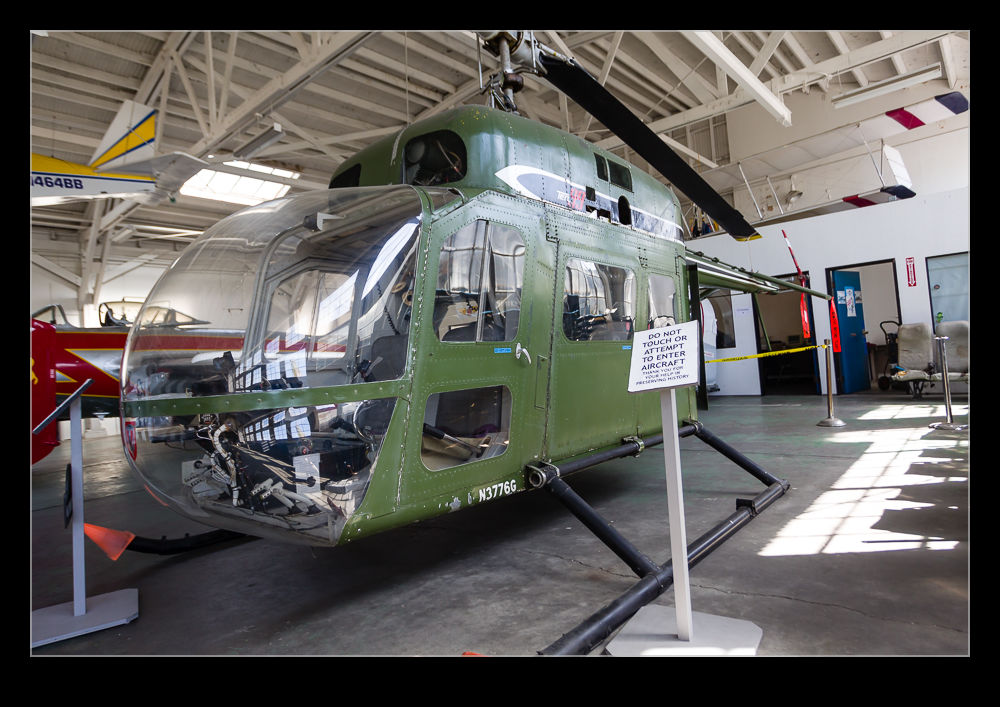 When you head outside, things are very different. A lot of more modern military aircraft are on display along with the flagship of the Museum, a Shorts Solent flying boat. The aircraft outside are quite close together although not very cramped. However, the combination of positions and the ever present overhead power lines makes getting an uncluttered shot a little tricky. Some imaginative angles are sometimes required. It was a bright day as well so the harsh light was not helping.
When you head outside, things are very different. A lot of more modern military aircraft are on display along with the flagship of the Museum, a Shorts Solent flying boat. The aircraft outside are quite close together although not very cramped. However, the combination of positions and the ever present overhead power lines makes getting an uncluttered shot a little tricky. Some imaginative angles are sometimes required. It was a bright day as well so the harsh light was not helping.
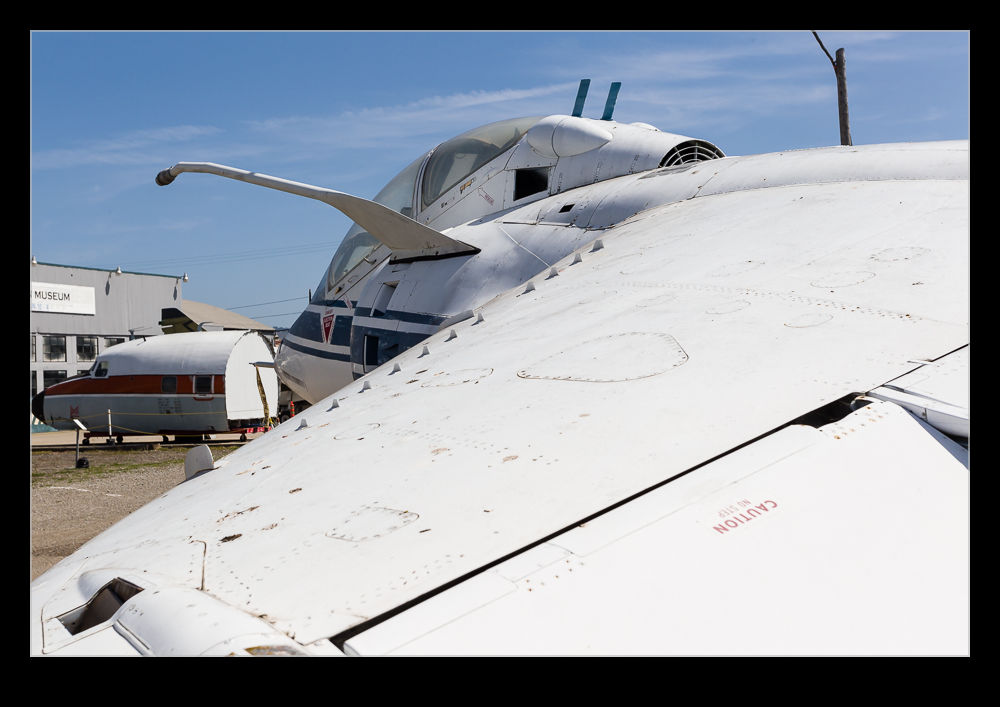 While the F-14, the A-3 and the TAV-8A are worth a bit more time, it is hard to ignore the Solent. It is set facing the parking lot so it is striking as soon as you arrive. Internal tours can be arranged and, had I been able to stay longer, I would have been able to take a look around. However, I had to make do with external only this time. The rudder is currently missing and the wing floats are dismounted but the aircraft is still in great condition. The shaping of the nose is a feature of that era of flying boats and you can’t help but want to accentuate it when photographing her.
While the F-14, the A-3 and the TAV-8A are worth a bit more time, it is hard to ignore the Solent. It is set facing the parking lot so it is striking as soon as you arrive. Internal tours can be arranged and, had I been able to stay longer, I would have been able to take a look around. However, I had to make do with external only this time. The rudder is currently missing and the wing floats are dismounted but the aircraft is still in great condition. The shaping of the nose is a feature of that era of flying boats and you can’t help but want to accentuate it when photographing her.
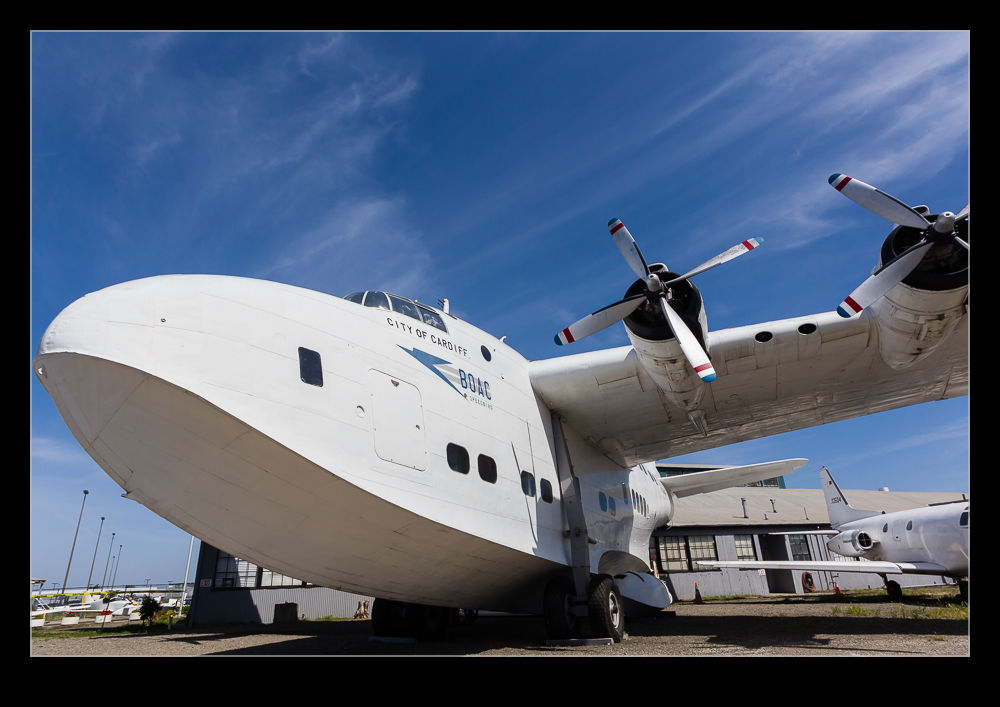 Even events are held at the museum and some night photography might provide some interesting opportunities. I do want to see inside the Solent so I shall be heading back before too long.
Even events are held at the museum and some night photography might provide some interesting opportunities. I do want to see inside the Solent so I shall be heading back before too long.
